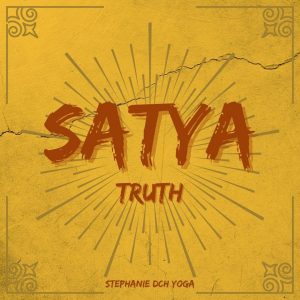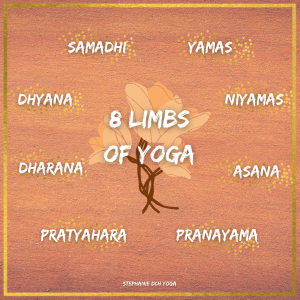Satya
 Satya means ‘truthfulness’; not telling lies, and living your truth.
Satya means ‘truthfulness’; not telling lies, and living your truth.
A few weeks ago, I introduced the first Yama, Ahimsa. Have a read of my Ahimsa blog post here. Today, we arrive at the second Yama, Satya. Honesty is usually considered a virtue, so it may be no surprise that this appears as one of the Yamas (the moral and ethical guidelines underpinning yoga). It can be easy to brush off Satya as one we think we understand; a concept that doesn’t need our attention or input to do correctly. If you’re anything like me, you probably assume you’re a generally pretty honest person, and don’t like to deceive people. However, Satya is a little more nuanced than it may first appear.
An important dilemma to consider is, ‘what if, by being truthful, I harm someone?’. This, of course, goes against the first Yama, Ahimsa, meaning non-violence. Ahimsa is the first and most important Yama, and supersedes all other guidelines within yoga, including Satya. We must first ask, ‘are we acting kindly and with love?’ before all other action is taken. Therefore, before we spread truth, we must ensure our actions are kind and will not have a harmful outcome.
Patanjali’s Sutras
Nobody quite knows for sure who ‘Patanjali’ is. Some believe Patanjali was a sage who lived around the second century BCE. Others suggest that Patanjali was a group of people. There are also myths that Patanjali was a manifestation of a God. Whoever Patanjali was, they wrote the Yoga Sutras. It is within the Yoga Sutras that we find the 8 Limbs of Yoga. Within these, we find the Yamas. Within the Yamas, we find Satya.

That was a bit of a Russian doll-esque journey! I hope you’re still following, and if you aren’t don’t sweat it! It is a lot to take in. I think it is important to look at what Patanjali wrote about Satya if we are to try and understand what was meant by the communication of this concept. This Yoga Journal article contains an interesting reminder that Patanjali communicated the Yamas as restraints, therefore what does it mean to implement the concept of Satya as a restraint rather than as a thing we have to ‘do’?
Perhaps practicing Satya involves being more mindful of what we say; after ensuring that what we are about to say is nonviolent, we might consider whether it is an objective or subjective statement. Of course, we need to communicate our subjective needs sometimes, but we might endeavour to think more holistically about the things that we believe to be ‘fact’. This involves stepping outside of our own personal experience and trying to view things from other angles and perspectives before we create an opinion around something.
‘You have to be cruel to be kind’
Sometimes, the truth hurts. I have a mental image of the words ‘Satya’ and ‘Ahimsa’ clashing, here, and it creates all sorts of moral confusion for me! Let’s break it down. I think that what is important, here, is the intention of the truth. It is usually an accepted fact that the truth is important, even if it causes harm initially. In the long run, truth allows people to make informed decisions. A few examples that spring to mind are:
- Knowing that your friend’s partner has been unfaithful to them. Do you tell your friend and therefore cause hurt right now so that they may be happier later on? (We could argue that the hurt was not caused by you, of course!)
- Someone asking you, ‘do you like my new haircut?’. It might look dreadful, but that is your opinion. Still, do you tell them your opinion, or do you allow them a confidence boost by telling a white lie? Perhaps you could argue that if they wanted an honest answer, they need to be ready for differing opinions!
Satya for the self: ‘Living your truth’
Are you cringing? Sometimes I cringe at this phrase, because it is often accompanied by someone claiming to have found ‘the way’, or ‘the answer’ or ‘the meaning of life’. Even worse, someone telling you how to live YOUR truth! (Sidenote- if anyone calling themselves a ‘Guru’ comes at you with advice, RUN AWAY! More on that another time!)
What does it mean to ‘live your truth’? Let’s take a look at what you can implement during a yoga class that would mean you were practicing Satya.
Picture this: you’re at a class with me in Prestwood or Ballinger and I suggest a few options for a pose. You choose to ignore the stiffness in your lower back, the restrictions in your breathing, and force yourself into a more difficult variation of a pose. We have ALL done this. I STILL do this sometimes. We have ignored the truth, in this situation. Instead of listening to our body telling us, ‘this is far enough for today’, we have yanked our body into a shape for which it was not ready. Why? Because the truth hurts our ego sometimes. We want to do the ‘impressive’ looking pose because it makes us feel proud. Satya, and yoga in general, are humble practices. Yoga is stilling the mind, sitting with the truth and remaining mindful. Pride, pushing yourself to the point of harm and lauding your flexibility over others is not Satya, Ahimsa, or Yoga!
When I teach, and when I practice myself, I try to communicate the idea of ‘just being’. Allowing what is there to be there. Mentally acknowledging that painful memory that has popped up during pigeon pose, and continuing to breathe anyway. Mentally acknowledging that anger at your friend because they have let you down, and continuing to breathe anyway. Mentally acknowledging the grief of a lost family member, and continuing to breathe anyway. The truth HURTS sometimes, but not allowing yourself to feel these things can manifest in more chronically painful ways.
I thought I was really good at this (hello, ego) until a therapist recently pointed out to me that I was not allowing myself to feel my emotions. Distracting myself with tasks and a brave face was not helping me (I was not practicing Satya). She encouraged me to acknowledge those difficult feelings, breathe, notice where in my body I felt them. My gosh, has that been a revelation for me!
I don’t write this post because I believe I understand the concept of Satya completely (far from it!). Nor do I practice Satya all of the time because (paradoxically) that is not my truth. I think that being aware of these concepts and implementing them when you can, discussing them, mulling them over, is a good way to practice yoga. In the end, the purpose of yoga is ‘Chitta Vritti Nirodhah’, or ‘To still the fluctuations of the mind’, so if this is causing more stress than you started with, step back a little and take a deep breath.
In writing this post I have been reminded of a beautiful mantra;
Asatoma Sad Gamaya
Tamasoma Jyortir Gamaya
Mrityorma Amritan GamayaLead us from falseness to truth
Lead us from darkness to light
Lead us from poison to nectar
Lead us from death to immortality
Have a singalong, repeat lots and lots of times, hum it in the shower! You can find lots of mantras for all manner of feelings, vibes and intentions on Youtube and Spotify. I have been practising this mantra this week and have felt it has grounded me and allowed to me to start to rejoice in what it means to be me, something I have struggled with a lot lately. The magic of Sanskrit is that it is a vibrational language; each syllable and word vibrates with the very essence of the meaning of itself. By reciting Sanskrit mantras, you evoke the essence, or manifest the words which you are reciting. I love to discuss yogic concepts and welcome your thoughts! If you live near Thame or Prestwood, check out my classes page, I would love to practice with you.
In the wise words of Dolly Parton- ‘Find out who you are, and do it on purpose’.
Peace!
Stephanie x